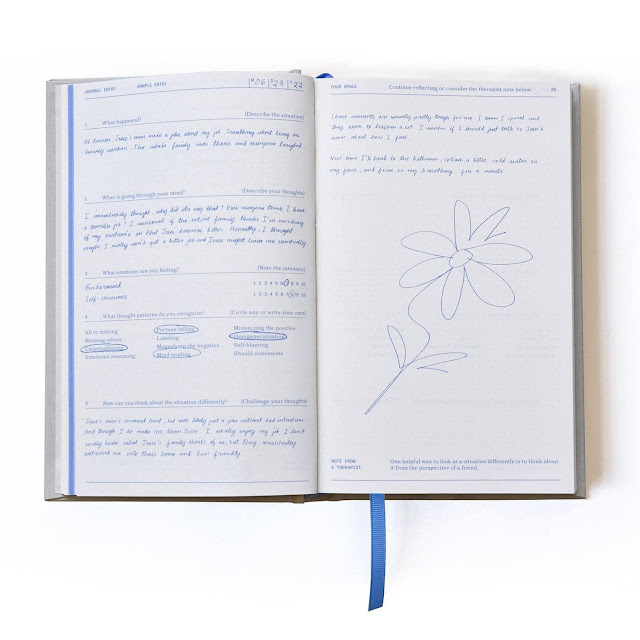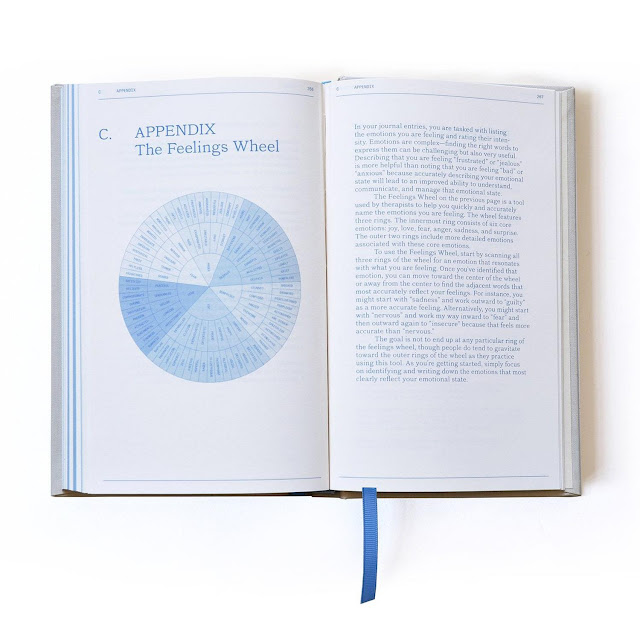The Anti-Anxiety Notebook by Therapy Notebooks
"Cognitive Behavioral Therapy (CBT) is based on a simple yet powerful insight: Our thoughts impact our feelings. If we learn to better understand and manage our unending trains of thought, we will feel better."
THE ANTI-ANXIETY NOTEBOOK
I’ve been in some form of therapy for the past two years. A variety of individual and group therapies specializing in Cognitive Behavioural Therapy, Dialectical Behavioural Therapy, Acceptance Commitment Therapy, and many other kinds. What comes with these varying types of therapy is an incredible amount of worksheets. I have a hard time keeping track of the work I do in these groups, and have folders bursting with paper. It makes it difficult to find anything I want to look back on.
The reason I attend therapy is for severe anxiety, anorexia nervosa and bipolar disorder. I’ve always found CBT and DBT to be extremely helpful, but I have a hard time keeping track of the worksheets, often finding them scattered them all over my apartment.
I was thrilled when I came across The Anti-Anxiety Notebook by Therapy Notebooks, and loved the idea that everything could be condensed into one journal sized notebook.
Designed by therapists, the Cognitive Behavioural Therapy-based notebook entries are made to help you track your emotions, become more aware of thought patterns, and grow over time specifically to reduce anxiety and manage stress.
One of the most helpful tools I've learned in my ongoing therapy is the importance of journaling, and I've filled over five chunky journals in the past two years. Sometimes, even when I don't feel like journaling, I'll start writing something and the words will all of a sudden start pouring out of me.
In The Anti-Anxiety Notebook, there's space for 100 evidence based CBT formatted journal entries. Since receiving the book, courtesy of Therapy Notebooks, I've been filling these pages with my feelings and emotions on an as-needed basis, usually daily. I still do use my regular journal for overflow, since I tend to write a lot.
What I loved about the journal entries was how they were laid out and the questions each one asked. Questions such as 'What is going through your mind?' and 'What emotions are you feeling?' The Anti-Anxiety Notebook states that "the purpose of this journal is to help you process your emotions and experiences in a constructive way."
There are tips for when it comes time to fill in the journal entries, which I found really helpful. For example, under the 'What happened?' section of the entry, the book recommends focusing on the facts and suggests being brief and specific. The thought patterns section makes it clear that naming our thought patterns makes them less huge, intimidating, and threatening.
I've learned a lot about thought patterns over the years, and what unhelpful thought patterns I use regularly. If you're not familiar with automatic thought patterns, this book does a fantastic job at talking about them in depth towards the end of the book. What I've learned from therapy and CBT groups is that I'm an all or nothing thinker, I catastrophize, and I'm a mind reader. These are my cognitive distortions. Reading this book, and using the journal entries will help you figure out what cognitive distortions result in negative thinking and emotions for you.
Other sections in the book, spread out between the journal entries, talk about how change is possible, the power of breath and mindfulness, sleep therapy, having positive relationships, and using distraction techniques.
I really liked the distraction section of the book. I've always found some form of distraction helpful at delaying whatever behaviour an event might trigger. In my case, with my eating disorder, I might be triggered to engage in harmful behaviours after eating a meal. By using a distraction, such as crocheting, going for a walk, or watching a movie, it can help me delay that behaviour and effectively manage my stress around the event. It's important to note when it comes to distraction that it's best used as a delaying tool, and not a tool for avoidance. This book recommends setting a limit on the time or frequency of the distraction.
One thing that really resonated with me from The Anti-Anxiety Notebook was the feelings wheel. I struggle with emotion regulation and often have a hard time naming what I'm feeling when I'm feeling it. I become overwhelmed and my automatic reaction when a therapist asks how I'm feeling is, "I don't know!" Looking at the feelings wheel was extremely helpful, since it shows what the various feelings are, and aids you in choosing what you might be feeling at that moment. The book states that the feelings wheel "is a tool used by therapists to help you quickly and accurately name the emotions you are feeling." Just naming a feeling might seem like a small thing, but when you struggle with anxiety or other forms of mental illness, to be able to put a label on how you're feeling is actually a big feat.
Overall, this is a wonderful notebook. It certainly isn't a cure for anxiety or an alternative to therapy, but is a fantastic aid. The structured journal entries will help you identify the triggers of your anxiety, the intensity of it, what unhelpful thinking styles or cognitive distortions led to you feeling that way, and will help you to look at things differently. I highly recommend this if you struggle not only with anxiety, but with other forms of mental illness. I find CBT highly effective for my eating disorder and bipolar. Just being able to track my moods, triggers, and emotions has helped me to initiate some change.
I also think The Anti-Anxiety Notebook would be a great gift for someone that you know is struggling. Rather than giving them an unstructured journal, which can sometimes go to waste, I recommend giving them the gift of CBT in the form of this notebook.
Therapy Notebooks have done a fabulous job condensing what would usually be an overwhelming amount of worksheets into a small handheld notebook.


